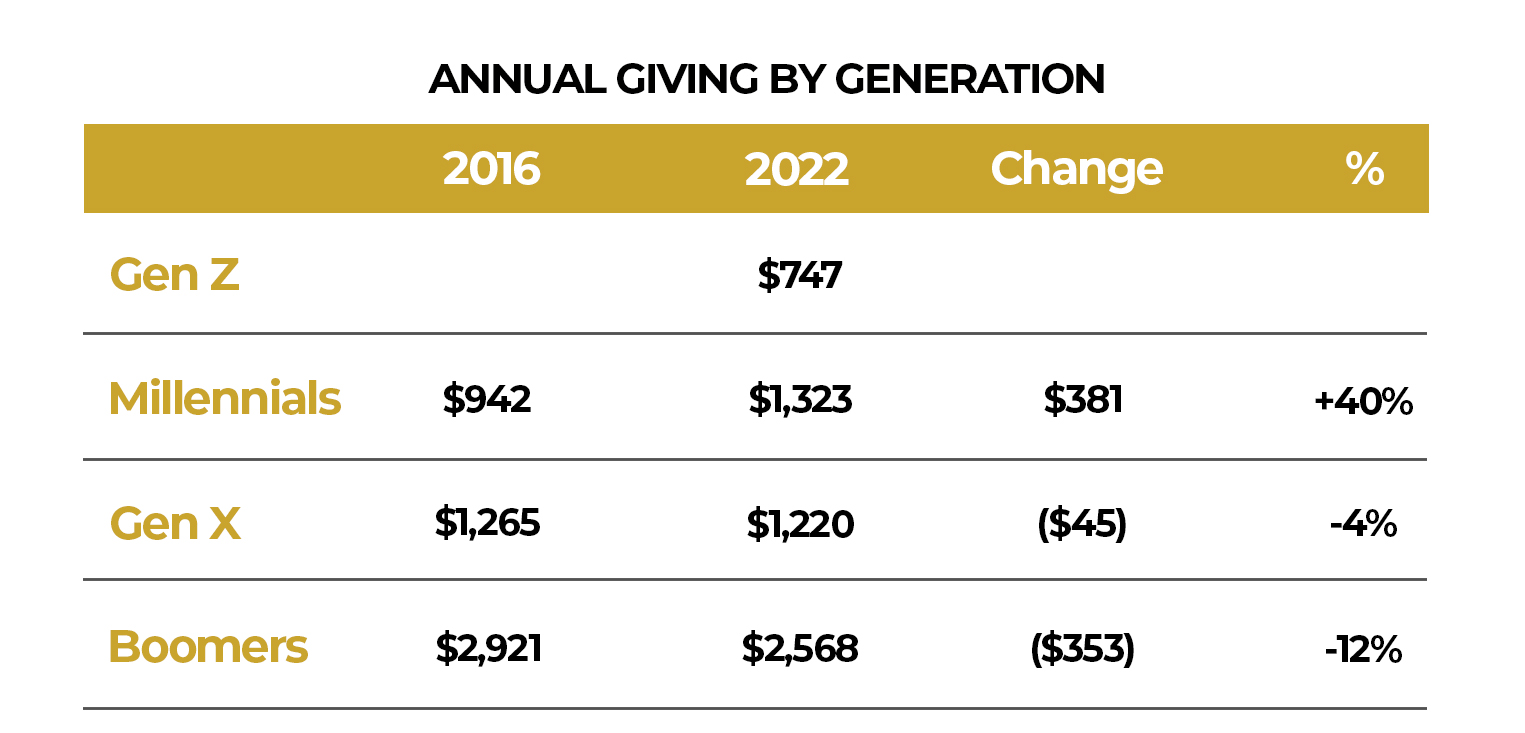Leveraging Donor Data to Navigate Turbulence in Good and Bad Economic Times
Understanding donors’ motivations based on evidence is key to effective fundraising. On the surface, that’s a logical concept, but so many fundraising organizations overlook the importance of analyzing data and instead keep doing what they’ve always done – because it works every now and then.
But “every now and then” isn’t enough – and in fact over time can be detrimental to your bottom line. Basing your efforts on empirical data and trends about your donor audiences and prospects can help you improve those numbers, leading to a higher return on investment and a reduction in expenses that don’t translate into profits.
By analyzing existing data and tracking campaign activity, nonprofit organizations can better understand what worked, what didn’t and why. As a result, you can use these metrics for future endeavors, leading to increasingly meaningful results with every campaign.
The Historical Dip in Charitable Giving
Since 1980, charitable giving continued on an upward trajectory with only minor dips related to overall economic conditions. But in 2022 that all changed.
Since 2022, there has been a dip in charitable giving of historical proportions, which has impacted some industries and regions more than others.
There are many theories about why this occurred, but it is likely due to a combination of factors that led to the perfect storm.
During the COVID-19 pandemic, the rate of the increase in charitable giving was inflated for a few reasons. Disposable income increased significantly due to COVID-related government assistance, as well as savings due to shelter-in-place and travel restrictions. Additionally, large corporations and big donors felt the need to expand their support for others’ well-being.
However, that didn’t last – leading to the significant dip in 2022-2023. As inflation grew significantly in 2022-2023, many small donors grew concerned about their own financial stability and possibly experienced job loss, which led them to stop or postpone supporting their favorite charities.
According to Giving USA (Giving USA: The Annual Report on Philanthropy for the Year 2022 (2023). Chicago: Giving USA Foundation), in 2022, Americans gave $499.33 billion to charity, a 3.4 percent decline compared to 2021. Adjusted for inflation, total giving declined 10.5 percent.
Of that $499.33 billion, 64 percent (or about $319 billion) was given by individuals – a 6.4 percent decline from 2021. However, giving by foundations, bequest and corporations actually increased by 2.5 percent, 2.3 percent and 3.4 percent, respectively.

These numbers illustrate the importance of recognizing how the state of the economy and other trends impact individuals and families, and nonprofit organizations must navigate and address these changes in a personalized, meaningful and compassionate manner.
The Power of Data Insights
With a better understanding of why certain results are generated, it’s easier to pivot when outside forces – such as donors’ financial status, job loss or even a pandemic – impact your efforts. Your insights based on data can help you rethink your approach and offer a path to address changes in market conditions.
Understanding how donors currently engage with the organization will help predict future engagement and make changes that don’t negatively impact results.
Many analytical metrics can help you understand your audience, their behaviors, what works, what doesn’t, how people are interacting with your organization and more. Analyzing and collecting the following metrics can be extremely valuable in identifying the right audiences for your fundraising goals:
- Average gift size, number of gifts and frequency of giving
- Costs per dollar raised and donor acquisition costs (return on investment)
- Donor lifetime value and retention rate
- Email open and click-through rates
Tracking this information will also help you avoid unnecessary costs – such as by no longer sending communications to individuals or organizations that are not responsive. When you do so, you can focus on audiences that are engaged, which is more likely to increase your return on investment.
By understanding current trends and donors’ interests and behaviors, you can plan for more meaningful and effective fundraising campaigns – whether you are hoping to reengage lapsed donors, grow your donor base or increase the dollars that you generate.
1. Identifying the Demographic Makeup of Your Donors
Understanding demographic factors related to your donors helps you make decision on where to invest for fundraising success.
As you analyze the demographic makeup of your donors, remember to study metrics related to which channels were most effective in reaching them – whether it was through social media, direct mail, email, organic searches or in-person communication.
Consider breaking down your ideal audience into groups of personas based on age, location, interests or other factors, which may allow you to communicate with them in ways that are more impactful.
With the help of data analytics and machine learning algorithms, nonprofits can forecast which donors are likely to increase their giving, become recurring donors or engage in other meaningful ways.
For example, according to a Giving USA report, millennials significantly increased their giving from 2016 to 2022, while other cohorts reduced their giving. Nonprofit organizations that are knowledgeable about this trend can therefore target more ideal audiences and reduce expenses.

2. Understanding Current Donors to Acquire New Donors
With vast amounts of information at their fingertips, nonprofits have the opportunity to gain valuable insights into donor behavior, preferences and engagement levels. This wealth of data can be harnessed to not only understand how people are currently engaged but also predict how they might become engaged in the future.
To encourage existing donors to maintain or increase their level of support, it’s essential that they feel like they are making a difference. Help them see how impactful their contributions are by sending emotionally engaging, personalized communications to them. By nurturing the relationship through regular touchpoints, you just may find them converting from occasional supporters to lifelong major donors
Along with leveraging data-led insights, having a strong understanding of nonprofit fundraising principles can help you build a sustainable base of donor support and encourage donors to strengthen their commitment to your mission, even when times are tough.
3. Re-engaging and Converting Lapsed Donors
Various studies indicate that this downward trend in giving will continue into 2024.
According to the Fundraising Effectiveness Project (FEP), the number of donors industrywide fell for the ninth straight quarter in the third quarter of 2023. Donors were down 7.6 percent, and new donors were down 16.9 percent.
However, nonprofit organizations can use past data and obtain new metrics in order to navigate the coming months. Donors still want to support the organizations they care about most, so if you can identify them and personalize communications to them, you may be able to get them to not only reengage but also increase their support of your organization.
By examining past donation history and interactions, nonprofits can identify the most loyal and committed donors. This insight helps in recognizing donors who have the potential to become major supporters in the future. Moreover, understanding the channels through which donors prefer to interact allows organizations to optimize communication strategies and meet donors where they are most receptive.
When you are armed with data, you can also personalize communications in order to reengage lapsed donors. Personalized communication is a game-changer in donor engagement. By tailoring emotionally engaging messages based on donor interests and preferences, nonprofits can forge deeper connections and increase the likelihood of donor support.
4. Breaking Down Silos for Success
Fundraisers and database teams often work in silos, which means that one team or the other is excluded from crucial discussions regarding fundraising strategy. It’s important to break down these barriers, as any effective, broad-based annual giving effort depends on understanding the donors in your database and having the confidence that your data is current and clean. Individual departments can also provide insightful facts or ideas based on relevant experiences.
Leveraging the data effectively and integrating it into the organization’s fundraising decision-making processes is essential, and collaboration among all the internal teams can unlock the potential found within the organization’s data resources.
As you collaborate, you may find that you can unlock the potential to turn low-level donors into major donors as well.
While the potential benefits of database integration are clear, the reality is that many nonprofits struggle to bridge the gap between fundraising and donor data. These two areas often work in isolation or in some cases data expertise is not available in an organization, hindering the seamless flow of data-driven insights to enhance fundraising efforts.
An Investment that Pays Dividends in Good Times and Bad
Understanding your donors and audience segments within them on a deeper level takes time, but it’s an investment that will lead to positive results in both good and bad economic climates.
This greater understanding can help you cultivate relationships with major donors and gain their support at an increased level. It also can help you find and convert additional donors of all sizes.
At Phoenix Innovate, we use data-led insights, personalized communications and our years of experience and expertise to help nonprofit organizations meet their fundraising goals and weather storms that may come their way. These are just a few of the solutions we’ve developed to help our clients in the nonprofit sector:
- Hyper-personalization of membership renewal letters increases return on investment for WGVU Public Media.
- After discovering untapped potential in its donor database through low-level and major-donor contacts, our nonprofit fundraising solutions led to a 40 percent increase in individual giving to the Animal Welfare League of Alexandria.
- Comprehensive data review and redesigned marketing strategies help Northwood University achieve its enrollment goals.
- Data analysis and segmented messaging strategy reduce expenses and increase gifts to Detroit Zoological Society.
- By updating Emancipet’s donor data file, we uncovered valuable insights that helped generate a 30 percent increase in annual revenue for the nonprofit pet clinics.

